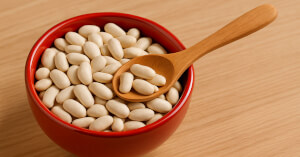Licorice RootBenefits, Uses & Dosage
Licorice Root (DGL) is used for digestive health, particularly for soothing heartburn, ulcers, and gastrointestinal issues.
Licorice Root (DGL), short for deglycyrrhizinated licorice, is a modified form of the traditional herb Glycyrrhiza glabra. DGL is commonly used to support digestive comfort without the blood pressure–raising effects of glycyrrhizin.
DGL may help soothe the mucous membranes of the stomach and esophagus, making it popular in formulations for heartburn, indigestion, and ulcers. It’s often taken as chewable tablets for optimal mucosal contact.
People use DGL for digestive relief and to promote gastrointestinal health. While traditional use is well-known, more controlled clinical trials are needed to confirm its effectiveness in modern therapeutic applications.
Other names & forms of Licorice Root supplement : licorice root (dgl), glycyrrhiza glabra, deglycyrrhizinated licorice, dgl licorice, licorice root extract
Benefits
Licorice root (DGL) provides gentle digestive benefits, particularly for soothing the stomach lining and supporting gastrointestinal healing:
- Digestive Health: DGL licorice is famous for its ability to support digestive comfort and help protect the stomach lining from occasional irritation.
- Anti-Inflammatory Properties: Taking DGL may help reduce minor inflammation, contributing to pain relief for sensitive digestive tissues.
- Immunity: Some research suggests that DGL may help support immune defenses in the digestive tract, helping maintain healthy mucous membranes.
Dosage
Licorice Root supplement is typically taken in doses depending on individual needs and health goals:
- Digestive support (DGL): 380–760 mg of deglycyrrhizinated licorice (DGL) before meals, typically in chewable tablet form.
- Ulcer and GI relief: 2–3 tablets daily, each containing ~400 mg DGL.
- Whole root (non-DGL): Not recommended for prolonged use due to glycyrrhizin-related side effects (hypertension, potassium loss).
- Recommendation: Use DGL formulations for safety; avoid glycyrrhizin unless supervised by a healthcare provider.
Side Effects
Introducing Licorice Root (DGL) can soothe your digestive tract, but some individuals experience mild side effects. Keep an eye out for:
- Mild stomach upset or nausea when taken on an empty stomach
- Headache or lightheadedness in sensitive people
- Occasional edema or fluid retention if consumed in excess
- Possible increases in blood pressure with prolonged high-dose use
- Minor muscle cramps or weakness indicating electrolyte imbalance
Interactions
Possible interactions include:
- Proton pump inhibitors (PPIs) and H2 blockers: Licorice Root DGL may increase gastric pH, potentially reducing absorption of PPIs like omeprazole; space dosing by at least two hours.
- Diuretics: Licorice can promote sodium retention and potassium loss; when combined with diuretics such as furosemide or Dandelion Root, it may worsen electrolyte imbalances.
- Antihypertensives: Chronic licorice use may raise blood pressure; combining with ACE inhibitors or L-Arginine requires monitoring to avoid resistance to therapy.
- Corticosteroids: Licorice’s effect on cortisol metabolism may amplify steroid actions, increasing risk of Cushingoid symptoms; use cautiously under medical supervision.
Precautions
Before using DGL Licorice Root, ensure you aren’t in any of these higher-risk categories. If you are, check with a medical professional:
- Pregnant or breastfeeding women: Likely safe when deglycyrrhizinated, but always confirm with your doctor
- Individuals with hypertension: Even DGL can influence blood pressure; monitor closely
- People with kidney disease: Risk of sodium retention and electrolyte imbalance; use with caution
- Those with heart disease: Potential to aggravate fluid retention; avoid high doses
- Patients on corticosteroids or diuretics: Possible additive effects on electrolyte levels; consult your physician
Studies
These studies provide scientific insights into Licorice Root benefits:
A 1978 double-blind, crossover RCT in 38 chronic gastric‐ulcer patients found that 760 mg DGL three times daily for 4 weeks did not improve healing rates or ulcer‐area reduction versus placebo.
A 2012 randomized, placebo-controlled study of GutGard® (75 mg twice daily) in functional dyspepsia showed significant decreases in symptom severity (Likert scale –2.1 on day 30; P ≤ 0.05) and improved quality of life versus placebo.
A 2025 systematic review of Glycyrrhiza glabra in peptic ulcer disease reported positive trends in ulcer healing and reduced pain symptoms, though improvements did not reach statistical significance.
A randomized trial found that adding DGL extract to standard clarithromycin-based triple therapy for H. pylori increased eradication rates by 15% (82% vs 67%; P < 0.05) and reduced gastric inflammation.
This article was originally published on Stackbb.com, your trusted source for science-based supplement guides.
Important Disclaimer: The information provided on this page about Licorice Root supplement is for informational purposes only and has not been reviewed or validated by a medical professional. It is not intended to substitute professional medical advice, diagnosis, or treatment. Always consult your doctor or qualified healthcare provider before starting, stopping, or changing any supplement or part of your healthcare regimen. Individual needs and responses to supplements may vary, and what works for one person may not be appropriate for another.







